What Does the Caret Symbol Mean in Text?
The caret symbol (^) has extensive applications in text-related tasks. In proofreading, it indicates where words or characters should be inserted, ensuring document accuracy and coherence.
In programming, it represents bitwise XOR operations and exponentiation, contributing to code functionality. Mathematically, it denotes exponentiation, streamlining complex calculations.
Within text editors, it aids navigation and editing by marking the beginning of lines. Additionally, its ASCII code, Decimal 94, supports its diverse roles across computing systems.
Recognizing its multifaceted utility enhances comprehension of its significance in various disciplines. Explore further to understand its evolving prominence in digital communication and coding frameworks.
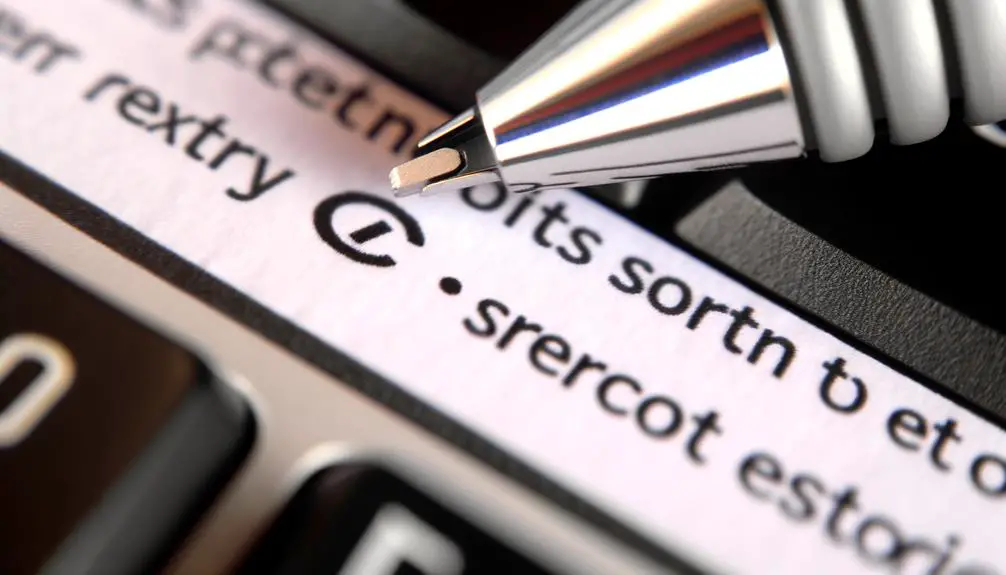
Key Takeaways
- The caret symbol (^) indicates where text insertions should be made in proofreading.
- In text editing, the caret helps navigate to the start of a line.
- It represents missing text or characters to be added in a document.
- The caret ensures document integrity and readability by marking corrections.
- ASCII code 94 is used to represent the caret symbol in digital text.
Origin of the Caret Symbol

The caret symbol (^) traces its origins to ancient manuscript annotations, where scribes used it to indicate the insertion of missing text. This practice was essential in ensuring the accuracy and completeness of handwritten documents.
The caret's distinctive form, resembling an upward-facing arrowhead, made it easily recognizable among other editorial marks. Over time, its utility expanded beyond manuscript correction to various fields, including mathematics and computing.
In mathematics, the caret symbolizes exponentiation, while in computing, it represents control characters or XOR operations. The symbol's enduring relevance underscores its versatility and adaptability across disciplines.
Understanding its historical context provides insight into its continued significance in modern text editing and digital environments.
Caret in Proofreading
In contemporary proofreading practices, the caret symbol continues to function as an essential tool for indicating insertions and ensuring textual accuracy. This symbol, resembling an inverted 'V' (^), is strategically placed within the text to denote where additional characters, words, or phrases should be inserted.
Proofreaders utilize the caret to maintain the integrity of the document, ensuring that omissions are rectified efficiently. By leveraging this symbol, professionals can deliver precise and clear corrections, enhancing the overall readability and coherence of the text.
The caret's role in proofreading is indispensable, as it provides a straightforward and universally recognized method for addressing textual modifications, thereby upholding the standards of high-quality written communication.
Caret in Programming
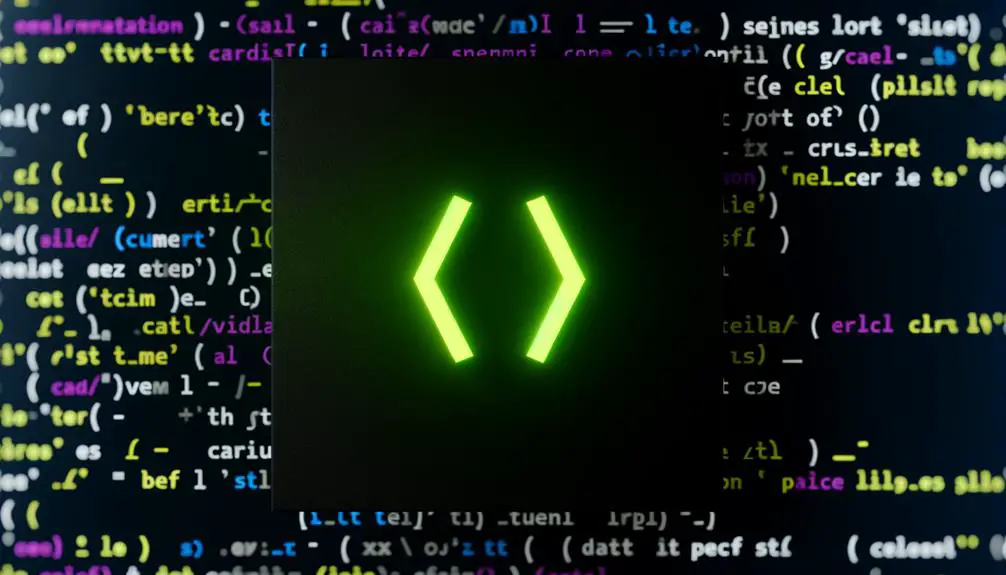
Within the domain of programming, the caret symbol (^) serves multiple purposes, including bitwise operations and exponentiation in various programming languages.
In languages such as C and JavaScript, the caret is used as a bitwise XOR operator, which performs an exclusive OR operation, comparing corresponding bits of two operands and returning 1 where they differ.
Conversely, in languages like Python, the caret denotes exponentiation, raising a number to the power of another.
It is essential for developers to understand these context-specific uses to avoid logic errors and optimize code efficiency.
The syntactical role of the caret hence exemplifies the importance of mastering language-specific operators for effective software development.
Mathematical Uses
Shifting from programming to mathematics, the caret symbol (^) in mathematical notation is commonly used to represent exponentiation, where it indicates that a base number is to be raised to the power of an exponent.
For instance, in the expression 3^4, the base number 3 is raised to the fourth power, resulting in 81.
This notation is particularly prevalent in computer science and digital contexts, as many programming languages and software applications adopt the caret for exponentiation due to its simplicity and ease of input.
The caret's adoption for this purpose highlights its utility in expressing complex mathematical operations succinctly, providing a clear and efficient means of conveying exponential relationships in various computational and algorithmic processes.
Text Editors Shortcuts
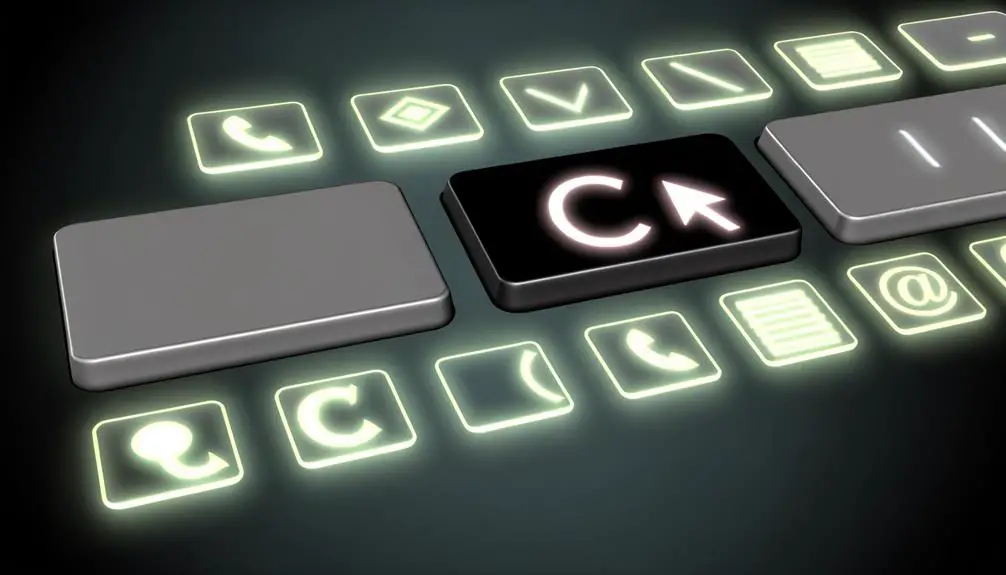
Text editors frequently utilize the caret symbol (^) as a shortcut for various orientation and editing functions, enhancing efficiency and precision in text manipulation tasks.
In many text editors, the caret is employed to indicate the start of a line, which allows users to quickly jump to or highlight the beginning of any line of text. Additionally, the caret symbol is often used in combination with other keys to perform actions such as selecting text blocks or orienting through code.
For instance, Ctrl + ^ might be used to mark text for copying or cutting. These shortcuts significantly streamline text editing processes, providing users with quick access to essential functions and thereby improving overall productivity in text management tasks.
Command Line Operations
Expanding beyond text editors, the caret symbol (^) also plays a pivotal role in command line operations. It is used for various control and navigation tasks that enhance command execution efficiency. This symbol is versatile and appears in several command line contexts:
- Command History Navigation: Quickly retrieve previous commands by combining with up/down arrow keys.
- Substitution: Replace text in previously executed commands to correct errors or modify parameters.
- Escape Character: Allows the inclusion of special characters in command lines.
- Conjunction: Combine multiple commands to execute them sequentially.
- Environment Variables: Reference variables within command scripts for dynamic content.
Each use case demonstrates the caret's functionality in optimizing workflows and streamlining command line operations, making it indispensable for efficient system management.
Caret in Regular Expressions
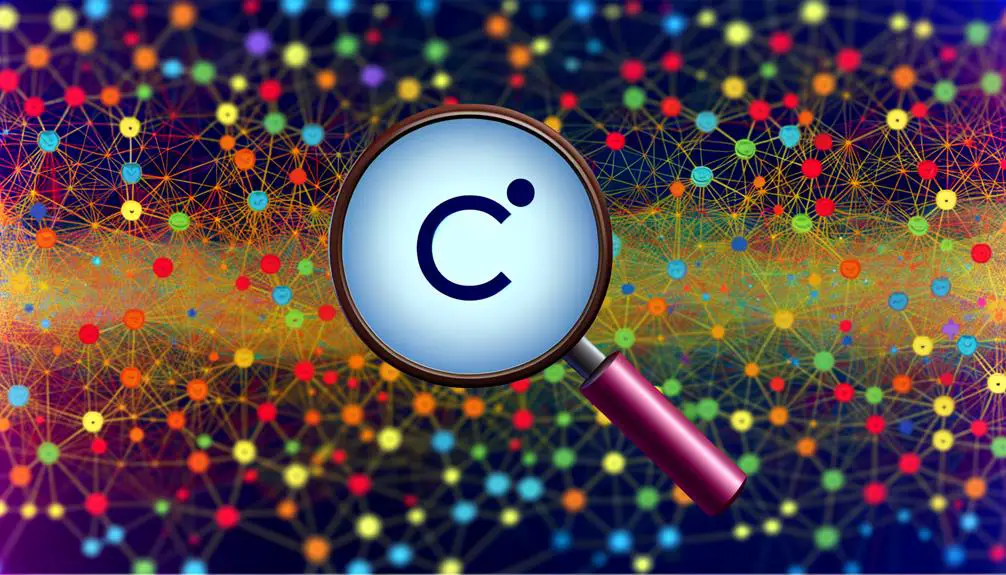
In the context of regular expressions, the caret symbol (^) serves as an anchor, denoting the start of a string or the beginning of a line within a string, thereby facilitating precise pattern matching. This functionality is essential for applications requiring strict text validation or parsing. For instance, the pattern `^abc` guarantees that the string starts with 'abc'. Here's a concise comparison to highlight its usefulness:
| Pattern | Matches Example |
|---|---|
| `^abc` | 'abc123', not '123abc' |
| `^\d` | '1abc', not 'a1bc' |
| `^hello` | 'hello world', not 'world hello' |
| `^\w+` | 'word123', not '123word' |
| `^A.*Z$` | 'A…Z', not 'A…Z…' |
This table illustrates how the caret symbol enforces the position at the start of a string.
HTML and Markup Languages
In the context of HTML and markup languages, the caret symbol (^) is not typically part of standard HTML tag syntax but is often utilized in various markup syntaxes to signify special instructions or annotations.
HTML relies on angle brackets (< >) to define elements, whereas other markup languages may incorporate the caret for unique functionalities.
Analyzing these distinctions is essential for understanding how different markup languages interpret and utilize symbols to achieve desired formatting and structure.
HTML Tag Utilization
Understanding the role of the caret symbol (^) in HTML and other markup languages is essential for creating well-structured and semantically meaningful web content. Although the caret symbol is not commonly used in HTML tags directly, it plays a significant role in related contexts such as regular expressions and scripting.
Here are some key points to keep in mind:
- Regular Expressions: Utilized within JavaScript or other scripting languages to denote string patterns.
- CSS Selectors: Employed in attribute selectors to match beginning strings.
- Character Entities: Represents specific characters when used in conjunction with ampersands.
- XML Parsing: Can be used in specialized markup languages derived from HTML.
- Command-Line Interfaces: Often appears in command-line operations involving HTML content processing.
Understanding these applications aids in leveraging the caret symbol effectively.
Markup Syntax Variations
Expanding on the versatile roles of symbols such as the caret, it is important to examine the various syntax conventions that HTML and other markup languages employ to structure and display content.
HTML primarily utilizes angle brackets (e.g., `<p>`) to define elements, while other markup languages like Markdown use symbols such as asterisks and underscores for formatting.
The caret itself, although not a common element in HTML, finds specific use in other contexts like regular expressions and programming languages, where it denotes string start positions or performs bitwise operations.
Understanding these syntactical variations is vital for web developers and content creators, as it guarantees the accurate rendering of structured information across different platforms and tools. Proficiency in these conventions underpins effective digital communication.
Caret in ASCII Code
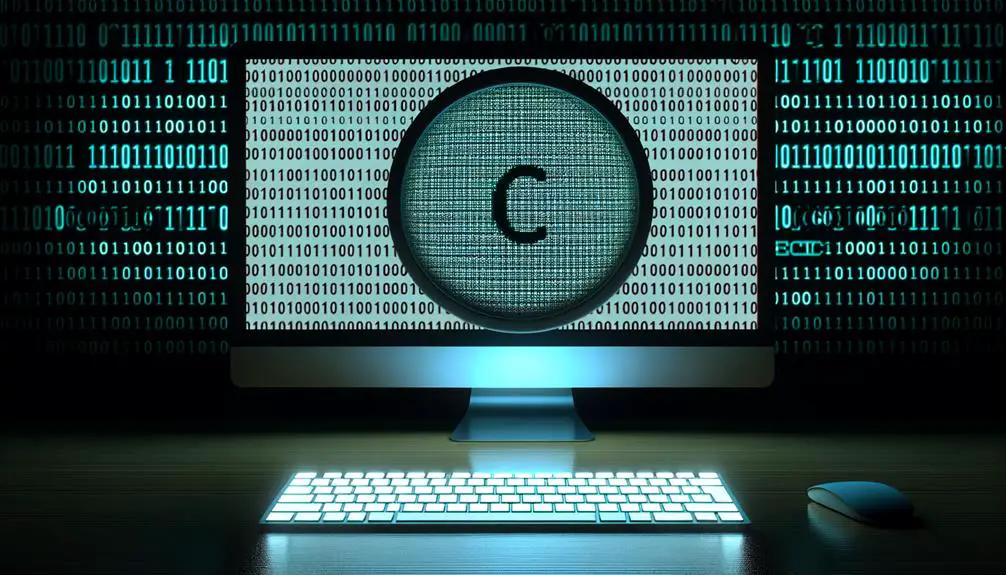
The caret symbol (^) is represented in ASCII code as character 94, serving a critical role in various programming languages for operations such as bitwise XOR or as a pointer indicator.
Its usage extends to numerous keyboard shortcuts, enhancing text editing efficiency in command-line interfaces and software applications.
Understanding the ASCII code definition and practical applications of the caret is essential for professionals working with text processing and computer programming.
ASCII Code Definition
In the context of ASCII code, the caret symbol (^) is represented by the decimal value 94 and the hexadecimal value 5E. ASCII (American Standard Code for Information Interchange) is a character encoding standard for electronic communication, which assigns a numerical value to each symbol.
The caret symbol, often used in text editing and command-line interfaces, is therefore precisely defined within this framework.
Key points about the caret symbol in ASCII include:
- Decimal Value: 94
- Hexadecimal Value: 5E
- Binary Representation: 01011110
- Character Classification: Printable and non-alphanumeric
- Usage Contexts: Text editing, command-line interfaces, and more
Understanding these aspects is essential for anyone working with text processing, encoding, or digital communication systems.
Usage in Programming
Leveraging its unique properties, the caret symbol (^) plays a significant role in various programming languages, serving as a tool for operations such as exponentiation, bitwise XOR, and more.
In languages like Python, the caret is utilized for bitwise XOR, where it compares each bit of two integers and returns a new integer with bits set to 1 if the corresponding bits differ.
Conversely, in languages such as BASIC and MATLAB, the caret denotes exponentiation, allowing for concise mathematical expressions.
Additionally, the caret serves in regular expressions within many programming environments, where it anchors patterns to the start of a string.
This diverse functionality underscores the caret's versatility and importance in coding syntax and operations.
Common Keyboard Shortcuts
Often employed in text editors and command-line interfaces, the caret symbol (^) is commonly accessed using specific keyboard shortcuts, reflecting its ASCII code designation. Understanding these shortcuts is essential for efficient text manipulation and command execution.
Here are several key methods to input the caret symbol:
- Windows: Press `Shift` + `6`
- MacOS: Press `Shift` + `6`
- Linux: Commonly `Shift` + `6`, but may vary by distribution
- ASCII Code: Hold `Alt` and type `94` on the numeric keypad
- Unicode: Input `002E` followed by `Alt` + `X`
These shortcuts facilitate quick and accurate insertion of the caret symbol, enhancing productivity in various computing environments. Grasping these techniques empowers users to navigate and manipulate text with precision.
Common Misunderstandings
A prevalent misunderstanding about the caret symbol (^) in text is its incorrect association solely with mathematical exponentiation, overlooking its diverse applications in programming, editing, and markup languages. This narrow perspective disregards its role in regular expressions for denoting the beginning of a string, or as a bitwise XOR operator in various programming languages. Additionally, the caret is utilized in text editors for indicating insertion points and in markup languages for special formatting commands.
| Context | Usage Example |
|---|---|
| Programming | `if (x ^ y)` (bitwise XOR) |
| Regular Expressions | `^abc` (matches 'abc' at start) |
| Text Editing | `^` (insertion point) |
| Markup Languages | `^text^` (special formatting) |
Understanding these contexts can greatly enhance one's technical proficiency.
Future of the Caret Symbol
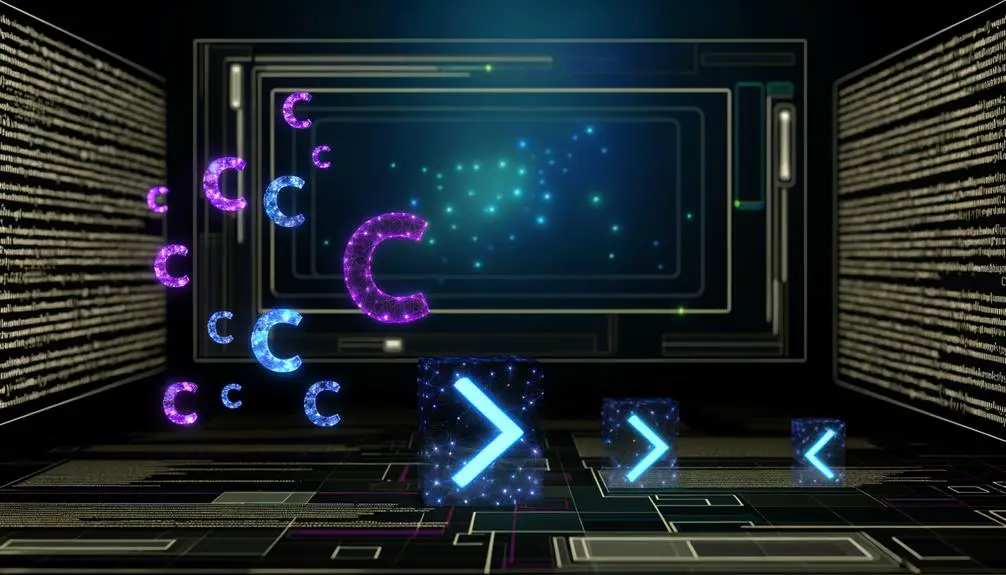
Examining the future trajectory of the caret symbol, we observe its increasing prominence in digital communication. This heightened integration within coding frameworks and its evolving role in text-based applications enhance its relevance.
As digital platforms expand, the caret symbol's utility in markup languages and programming syntax continues to grow. Concurrently, innovations in text processing and editing tools are likely to further embed the caret symbol into daily digital interactions.
Increasing Digital Usage
As digital communication continues to evolve, the caret symbol is increasingly being repurposed for various functionalities in programming, data structuring, and online interactions. The symbol's simplicity and versatility make it a valuable tool in diverse digital contexts. Its usage spans several critical areas:
- Command Line Interfaces: Represents command chaining and redirection.
- Text Editors: Indicates insertion points and text navigation.
- Markdown Formatting: Utilized for superscript text, enhancing document readability.
- Data Transmission: Functions as a delimiter in data parsing.
- Mathematical Notation: Denotes exponentiation in coding and documentation.
The caret symbol's expanding role demonstrates its adaptability to the demands of modern digital communication, providing a concise method for conveying complex instructions and structures.
Integration in Coding
The integration of the caret symbol in coding environments underscores its potential to streamline complex operations and enhance code readability.
In programming languages like Python and JavaScript, the caret (^) is frequently employed for bitwise XOR operations, enabling efficient data manipulation at the binary level.
In regular expressions, the caret serves as an anchor to denote the start of a string, aiding in precise pattern matching.
Its utility extends to command-line interfaces, where it acts as a control character, improving command execution.
As coding paradigms evolve, the caret symbol's role is likely to expand, driving innovations in error handling and syntax parsing. This highlights its significance in creating robust, maintainable codebases.
Evolving Text Applications
Advancements in natural language processing and text editors are poised to redefine the functionality of the caret symbol, expanding its applications beyond traditional usage. These technologies are driving innovative ways to utilize the caret in more complex and efficient manners.
Potential future applications include:
- Enhanced Text Prediction: Utilizing the caret for predictive text input in real-time.
- Syntax Highlighting: Employing the caret for context-aware syntax highlighting in coding environments.
- Error Correction: Facilitating more intuitive error detection and correction in text documents.
- Interactive Editing: Enabling dynamic content manipulation in collaborative writing tools.
- Voice Command Integration: Using the caret symbol as a marker for voice-command-based editing.
These advancements underscore the symbol's evolving role, cementing its importance in modern text applications.
Conclusion
The caret symbol, originating from proofreading, has evolved to serve multiple roles in programming, mathematics, and text editing.
Its significance extends to HTML and markup languages, while its representation in ASCII code underscores its technical utility.
Common misunderstandings arise from its diverse applications, yet its future remains promising due to its versatility.
The caret symbol's multifaceted uses demonstrate its indispensability across various fields, highlighting its ongoing relevance in an increasingly digital and interconnected world.






